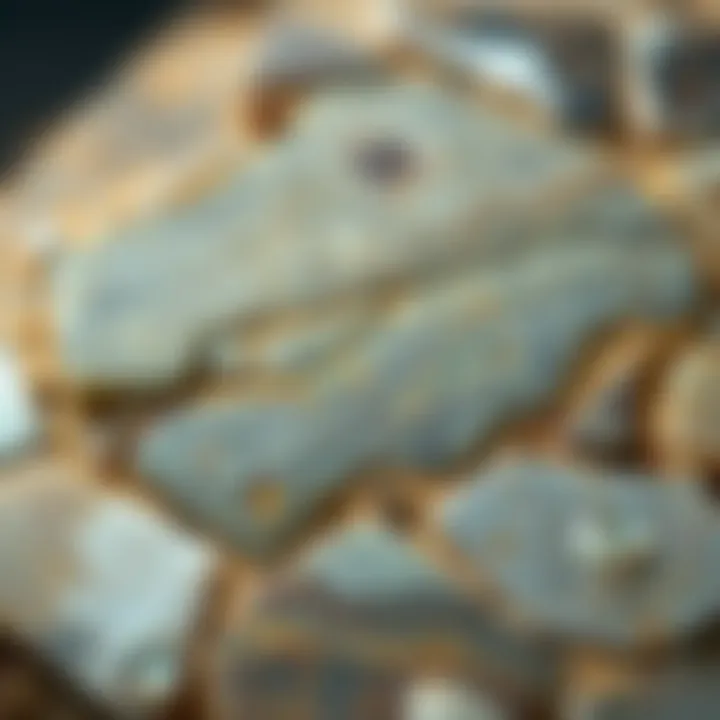Exploring the Unique Stones Used in Jewelry


Intro
In the realm of jewelry, stones serve not merely as adornments but as storytellers of the Earth’s history. Each stone, from the gemmy glimmer of diamonds to the deep hues of lapis lazuli, carries a unique tale—an anecdote woven from the very depths of the planet. Understanding these stones is not just about their surface shine; it dives deeper into their origins, properties, and the ages they have navigated. This article embarks on an exploration of the vast array of stones that find their home in jewelry—a journey that will enrich collectors and enthusiasts alike.
By categorizing these diverse stones, we bring clarity to their identities, revealing their distinctive characteristics and cultural significance. Ultimately, we aim to cultivate a greater appreciation for the artistry and craftsmanship that surrounds these natural wonders. In understanding their geological roots, beauty transforms from mere aesthetics to a profound comprehension of our planet’s history and artistry.
History and Origins
Overview of Collectibles, Rocks, and Fossils
For countless centuries, humans have been drawn to stones—not simply for their beauty but also due to their intriguing qualities. The earliest civilizations viewed gems as tokens of status, wealth, and power. Ancient Egyptians adored turquoise and lapis lazuli, using them to craft intricate jewelry for their pharaohs. The Romans considered emeralds a symbol of love, while in India, rubies were believed to bring good fortune.
In the world of collectibles, stones and fossils intertwine. Enthusiasts often seek out unique specimens not only for their visual appeal but also for their geological narratives. The interplay of rocks, minerals, and fossils tells tales of ancient climates, geological events, and children of long-dead worlds.
Historical Significance and Cultural Impact
Stones have always found themselves tucked into history’s nooks and crannies.
"Gems can symbolize love, wealth, and status, but they also embody stories of human creativity and natural history."
In various cultures, specific stones have held monumental significance. The belief in the metaphysical properties of gemstones stretches back to ancient traditions. Amethyst, esteemed for its ability to promote clarity and calm, plays a pivotal role in spiritual practice. Meanwhile, jade has been intertwined with Chinese culture for centuries, symbolizing purity and serenity. These meanings add layers to every piece of jewelry.
Moreover, the trade of gemstones has fostered international connections. The Silk Road, for instance, was a vein of commerce that saw stones traded across continents, embedding them into the fabric of different societies.
Identification and Classification
Guide to Identifying Rocks and Fossils
Identifying stones requires a blend of art and science. A practical guideline often comes into play here, focusing on key features such as color, clarity, and cut. The clarity of a gemstone, for example, can dramatically impact its value and visual aesthetic. Non-transparent stones can still be stunning; consider the opaque beauty of an opal or the milky structure of moonstone.
Rock and fossil identification typically involves:
- Color: The first impression; this can greatly influence perceived value.
- Hardness: This can be gauged using Mohs scale, a tool that measures the resistance of minerals to scratching.
- Luster: The way light interacts with the surface of a stone; is it shiny, dull, or resinous?
- Transparency: Whether the stone is clear, translucent, or opaque.
Common Types and Variations
Different forms of stones emerge based on their mineral compositions and natural formations. Common stones used in jewelry include:
- Diamonds: Coveted for their hardness and brilliance, often associated with everlasting love.
- Sapphires: Known for their royal blue hues, they can also be found in various colors.
- Emeralds: Distinguished by their vivid green shade, cherished for their rarity.
- Quartz: A diverse family that includes varieties like amethyst and citrine, recognized for their vibrant colors and accessibility.
- Turquoise: Famous in Native American jewelry, it captivates with its stunning blue-green color.
As we unwrap the layers of stones used in jewelry, the historical roots blend with modern meanings, crafting a richer tapestry of understanding. By studying the nuances of these stones, collectors can not only appreciate their intrinsic beauty but also the historical narratives they carry.
Preamble to Stones in Jewelry
The world of jewelry is as diverse and intricate as the human experience itself. At the heart of this craft lies a collection of stones—each with its own story, character, and charm. Understanding these stones is not merely about admiring their beauty; it's about appreciating a deep history interwoven through culture, science, and art.
Every gemstone tells a tale. Whether it’s the birth of the Earth itself or the hand of an artisan who has sculpted it into a lovely piece, every facet holds significance. For collectors, recognizing the variety of stones is crucial. It allows for informed choices when adding to their collection or selecting a perfect piece as a gift.
Key Elements of Stones in Jewelry
- Cultural Significance: Stones have been revered across cultures for centuries. Take the ancient Egyptians, who adorned themselves with lapis lazuli, believing it held protective powers. Each stone carries meaning that transcends its physical form.
- Unique Properties: From the dazzling spark of a diamond to the serene green of an emerald, each stone possesses unique qualities that affect its appeal. Hardness, clarity, and color are just a few characteristics that make specific stones desirable.
- Artistic Expression: Jewelers use stones as their palette, creating pieces that reflect personal style and artistic direction. The combination of shape, style, and stone results in wearable art that resonates with the wearer.
Considering the importance of stones opens a door to understanding their impact in the jewelry world. They are not just embellishments; they are integral elements that enhance the narrative of each piece. Moreover, the significance of naturally occurring stones cannot be overstated. They are an embodiment of nature’s artistry, shaped over millions of years.
Benefits of Understanding Jewelry Stones
- Informed Purchasing Decisions: Knowledge of different types of stones helps collectors and enthusiasts avoid common pitfalls, such as overpaying or buying synthetic pieces under the guise of natural stones.
- Enhanced Appreciation: Recognizing the elements that make each stone unique fosters a deeper appreciation for the craftsmanship involved.
- Connection with the Earth: Engaging with natural stones allows individuals to connect with geological processes and the environment, enriching their understanding of the world around them.
Considerations About Stones in Jewelry
When embarking on a journey into the realm of jewelry stones, one must consider both the ethics and aesthetics. Beyond the charm of a brilliant cut, due diligence in sourcing stones is vital. The rise of conflict-free stones has become an important facet of the conversation around jewelry, echoing the importance of ethical consumerism in today’s world.
The Allure of Natural Stones
When it comes to jewelry, stones bring a certain magic that synthetic materials just can't match. Their beauty is not just in their look but in their stories, origins, and the nature from where they come. Natural stones are products of geological processes, each with unique characteristics that can evoke emotion and admiration. Incorporating these elements into jewelry not only adds aesthetic value but also imparts a sense of authenticity and individuality that resonates with many collectors and enthusiasts.
Natural stones, whether they be gemstones or more rustic varieties, speak to the heart of craftsmanship and artistry. Their rarity and the tales behind their formations often captivate individuals, making them much sought after. By exploring these stones, one can appreciate not only their visual allure but also understand the fascinating journey they undertake from mines to magnificent adornments.
Defining Natural Stones
Natural stones are generally categorized as materials that have not been artificially altered or modified beyond their initial extraction from the earth. This means that their formation processes—through crystallization, sedimentation, or metamorphism—remain intact. These stones can be divided into two main groups: gemstones and organic materials.


Gemstones like diamonds, emeralds, and sapphires are the more familiar members of this family. However, natural stones extend well beyond these traditional gems. For instance, think about jade—a stone that has been considered sacred in many cultures. Then there are materials like turquoise and amber, which have their own tales and cultural significance.
Thus, natural stones can often be defined by:
- Origin: They stem from the earth’s crust through natural processes.
- Appearance: Their colors, textures, and inclusions vary vastly due to their diverse geological formation.
- Cultural Significance: Many cultures honor and attribute meanings to specific stones—like how garnet is a symbol of passion and energy.
The Impact of Color and Clarity
In the realm of natural stones, color and clarity are not just visual attributes; they play a crucial role in determining a stone’s desirability and overall value. The vibrancy of a stone's color can captivate the eye, but clarity—how transparent or clouded a stone appears—often tells a deeper story.
- Color: The variety of colors found in natural stones is staggering. Each hue, shade, or tint comes with its own psychological impact. For example, blue sapphires evoke feelings of calm and trust, while fiery red rubies are often linked to passion and vitality. Additionally, the presence of trace elements can significantly alter a stone's color, creating stunning variations.
- Clarity: Clarity refers to the presence of inclusions, which are internal characteristics that may affect a stone's visual appeal. A pure stone, devoid of imperfections, usually fetches a higher price. However, some collectors seek stones with unique inclusions as they can act as personal 'fingerprints' and add to a stone's character.
The balance between color and clarity often influences purchasing decisions. For instance, some may prefer an opaque stone with rich color over a clear one that lacks vibrancy. Therefore, understanding these attributes is vital for anyone collecting or appreciating natural stones, guiding them towards meaningful selection.
"Natural stones serve not just as adornments but as storytellers, linking us to the earth through their intrinsic beauty and history."
Types of Gemstones
Understanding the different types of gemstones is crucial for comprehending the vast world of jewelry. Each gemstone category tells a story about its formation, rarity, and the artistry behind its inclusion in adornments. This exploration enriches the insight into value—monetary and sentimental. Delving into precious and semi-precious stones not only helps collectors and enthusiasts identify quality but also satisfies a deeper need to connect with the rich heritage and craftsmanship behind these natural wonders.
Precious Gemstones
Diamonds
Diamonds command a unique place in the jewelry world. Known for their unparalleled hardness (rated a ten on the Mohs scale), they symbolize endurance and everlasting love. Their brilliant clarity, often enhanced through skilled cutting, catches light in a way few other materials can match. This dazzling shine is one of the reasons diamonds remain a sought-after choice for engagement rings and other heirloom pieces.
What sets diamonds apart, however, is not only their sparkle. Their emotional weight transforms them into symbols of status and luxury. On the down side, their high prices can be a barrier for some, and the ethical concerns surrounding diamond mining remain prevalent as well. Awareness around conflict diamonds—and opting for ethically sourced stones—can help balance desirability with responsibility.
Emeralds
Emeralds, revered for their lush green hue, have enchanted humanity for centuries. This gemstone represents rebirth and fertility, and its vibrant color screams luxury. Unlike diamonds, emeralds tend to have inclusions—often referred to as 'jardins'—adding to their unique character. Collectors often seek these stones not just for beauty but for history and provenance.
While their captivating look makes them attractive, the softness of emeralds, rated at 7.5 to 8 on the Mohs scale, might require extra care. Buying emeralds from reputable sources ensures not just quality but also ethical procurement. Their appeal continues as more people see their value beyond aesthetics, tapping into the emotive power they hold.
Rubies
Rubies are famed for their deep red colors, often associated with passion and vitality. They symbolize power and protection, making their presence bold and commanding. Their high durability, also ranking 9 on the Mohs scale, adds to their desirability, making them a popular choice across various types of jewelry.
One unique feature of rubies is the phenomenon known as asterism, or the star effect, which can occur in cabochon-cut stones. This feature adds to their allure, attracting collectors who appreciate rare qualities. However, it's essential to source rubies with clear documentation to ensure authenticity and value.
Sapphires
Sapphires are not just blue; they come in multiple colors, making them incredibly versatile. This stone signifies wisdom and royalty, finding its place in both casual and high-fashion jewelry. With a hardness of 9 on the Mohs scale, sapphires are suitable for daily wear, enhancing their practicality alongside beauty.
The unique characteristic of sapphires is the presence of colors other than blue, such as pink, yellow, and even colorless stones. Their wide availability and range of prices benefit collectors and casual buyers alike. However, the presence of treatments that enhance or alter color means buyers should be aware of what they're purchasing to avoid overpaying for treated stones.
Semi-Precious Gemstones
Amethyst
Amethyst is a popular semi-precious stone, often associated with calmness and clarity. It boasts a vibrant purple hue and occupies a special place in both ancient and contemporary cultures as a protective stone. Rated a 7 on the Mohs scale, amethyst is relatively durable, making it a favorite for various types of jewelry, from rings to necklaces.
One distinct feature of amethyst is its ability to change shades—from light lavender to rich violet—based on the presence of iron in the crystal structure. Their affordability compared to precious gems makes them accessible while still providing ample beauty and meaning.
Garnet
Garnets come in a variety of shades, but they are chiefly recognized for their deep red varieties. These gemstones are often linked with passion and energy, giving them an alluring charm. Garnets are rated 6.5 to 7.5 on the Mohs scale, providing a decent degree of hardness.
A noteworthy aspect of garnets is their unique color change properties, particularly in certain varieties, where they can appear different in varied light sources. This intriguing characteristic can add significant value if one gathers a diverse collection. However, like all gems, quality varies widely, so it is prudent to seek these stones from known dealers.
Topaz
Topaz is a fascinating gemstone, often found in several hues including blue, yellow, and clear forms. This seondary use makes topaz an adaptable choice for many styles and types of jewelry. With a hardness of 8 on the Mohs scale, it’s durable and user-friendly for designers.
One interesting element of topaz is the phenomenon of color treatment. Naturally occurring blue topaz is rare and often requires treatment to achieve a vibrant color. Understanding the source and treatment of each stone ensures knowledgeable purchasing.
Citrine
Citrine, the warm yellow variety of quartz, has garnered attention for its bright and sunny disposition, symbolizing positivity and joy. It's an affordable option, making it popular among a wide range of consumers. With a Mohs hardness of about 7, citrine is fairly robust and can hold up well in jewelry.
One distinguishing feature of citrine is its ability to capture and reflect light beautifully. It’s known for its lesser rarity when compared to other colored gemstones. Therefore, while an attractive gem to wear, citrine often lacks the investment potential seen with more precious stones. Its appeal, however, lies in its warm hues that light up any piece.


Stones in Cultural Context
The relationship between humanity and stones spans back millennia. Stones, especially those fashioned into jewelry, carry cultural significance that transcends mere aesthetics. They serve as symbols of status, spirituality, and identity across various civilizations. Understanding this cultural tapestry adds layers of meaning to the practice of jewelry making and collecting. Each stone is akin to a time capsule, encapsulating stories, beliefs, and customs that flicker through historical narratives. In this section, we will delve into the historical use of stones in jewelry, highlighting their transformative journey from ancient civilizations to modern trends, as well as the rich symbolism attributed to various stones.
Historical Use of Stones in Jewelry
Ancient Civilizations
In ancient civilizations, stones were not simply decorative; they held immense cultural value. Take, for instance, the Egyptians, who believed that turquoise offered protection and promoted fertility. The use of lapis lazuli was widespread, often associated with royalty and the divine. The resilience of these early tradesmen forged a path for the jewelry culture that remains influential today.
These civilizations often carved stones into intricate shapes, creating talismans and amulets believed to confer power or guard against the unseen forces. Such practices underscore how stones in ancient lore were interwoven with daily life, acting as both art and a representation of human beliefs and aspirations.
Renaissance and Baroque Eras
Fast forward to the Renaissance and Baroque eras, where the fascination with stones took on new dimensions. Artisans began to experiment, incorporating not only precious but also semi-precious stones into elaborate designs. The use of engraving and enameling became prominent, reflecting the vitality of rediscovered classical knowledge and the humanist spirit of that time.
Jewelry during these periods was often larger than life; a symbol of opulence and personal expression. Statements of wealth, such as the intricate settings showcasing large gemstones, became the norm. However, this fascination also dwindled towards the excess of the Baroque era, leading to a shift in appreciation towards simpler, more elegant designs in later epochs. This historical journey showcases how the attributes of stones have been admired, revered, and sometimes scrutinized with passing trends.
Modern Trends
In modern times, the landscape of stone usage in jewelry has seen a revolution. The contemporary consumer now places a premium on sustainable and ethically sourced materials. There’s an evident shift towards antique and vintage pieces that tell stories and reflect personal values, rather than mere extravagance. Here, stones are selected for their unique characteristics and the narratives they can convey.
Through this lens, jewelry evolves into a medium of self-expression; the characteristics of an aquamarine or the softness of rose quartz can reflect a person's individuality and beliefs. Yet, in the hustle of commercialization, the challenge remains to maintain authenticity in sourcing these precious materials, an aspect worth examining for collectors.
The Science of Stone Formation
The formation of stones is a critical aspect in understanding the very essence of jewelry making. This science ties into the way these stones are structured, classified, and ultimately how they exhibit qualities that appeal to artists and buyers alike. By delving into the processes that yield different types of stones, one can also appreciate the artistry behind the creation of gemstone jewelry. Furthermore, understanding stone formation helps in selecting stones that are not only beautiful but also enduring.
Petrology and Gemology
Petrology, the branch of geology specifically concerned with rocks and the conditions under which they form, offers invaluable insights into the characteristics of stones. This discipline lays the groundwork for gemology, which goes a step further to study gemstones specifically. Gemologists apply principles from petrology to evaluate stones, examining factors like clarity, color, and cut, which can significantly alter a stone's value.
If you're diving into the world of collecting stones, knowing these geological aspects is akin to having the key to a treasure chest. Imagine stumbling upon a dazzling amethyst, only to realize that its rich purple hue stems from the presence of iron and manganese during its formation. This knowledge not only enhances your appreciation but also aids in making informed decisions when sourcing these precious stones.
Formation Processes
Metamorphic Rocks
Metamorphic rocks, formed under immense heat and pressure, are truly fascinating in their ability to evolve from simpler forms into stunning gemstones. Take garnet, for instance. While it starts as a sedimentary rock, the geological forces transform it into a vibrant, multifaceted jewel. The key characteristic of metamorphic rocks is their intricate layering, which can lead to unique color variations. This unique feature makes them highly sought after in jewelry design, where each piece carries a part of Earth's history. Nevertheless, the translucent nature can sometimes lead to challenges in durability, hence a collector needs to choose wisely about care and usage.
Igneous Rocks
Igneous rocks come from cooled molten material, which offers them a fascinating story of transformation. Take granite, for example, though it finds more usage in architecture, it represents the birth of quartz crystals, which are frequently set in high-end jewelry. The trait of igneous rocks that stands out is their durability, making them ideal for pieces meant for everyday wear. However, while they showcase a hardiness, translucence may vary immensely, influencing their desirability. While unique cuts can enhance allure, one must be cautious about scratches and chips since they can mar the brilliance of these stones.
Sedimentary Rocks
Sedimentary rocks form from accumulated sediments over time, and they hold a remarkable place in the stone hierarchy. A prime example is lapis lazuli, which is often used for making ornamental jewelry items. The layers of minerals that create its deep blue color tell a tale of ancient ocean beds and river deltas. The key aspect of sedimentary rocks is their layered structure, which can add evocative mystery to any piece of jewelry. However, due to their composition, some may be more susceptible to wear and tear than igneous or metamorphic stones, making careful consideration in the jewelry context particularly important. A collector might need to think about protective measures to maintain such delicate beauty in their treasured items.
"Every piece of jewelry tells a story, one that begins long before it adorns the wearer, rooted deeply in the earth and shaped by time and nature."
In embracing the science behind stone formation, rock and fossil collectors open themselves not just to eager acquisition but to a deeper understanding of the natural world. This knowledge doesn’t only enrich their collection but contributes profoundly to their appreciation of the craftsmanship inherent in every piece of jewelry.
Acquisition and Authenticity
Acquisition and authenticity are pivotal in the realm of jewelry stones. When it comes to collecting or making informed purchases, knowing how to source genuine stones can make all the difference. The world is awash with options, and not all sellers have the collectors’ best interests at heart. Therefore, understanding where to find authentic stones and how to verify their legitimacy is of utmost importance.
Being aware of sourcing methods helps enthusiasts like rock and fossil collectors dodge pitfalls such as counterfeit stones or inflated prices. With genuine stones, collectors not only gain aesthetic value but also investment potential. Moreover, they contribute to a market that values quality over quantity, promoting ethical practices. After all, buying authentic stones preserves the integrity of the craft while supporting responsible sourcing.
Where to Source Authentic Stones
Certified Dealers
Certified dealers stand as a pillar of trust in the flood of stone suppliers available today. These professionals are recognized for their adherence to specific industry standards, ensuring that every stone they sell is genuinely what it claims to be. The hallmark of certified dealers is their commitment to quality and transparency, as they often provide certificates of authenticity for their stones.
For collectors, this means a solid assurance that the investments they make are worthwhile. The major advantage of certified dealers is that they often build relationships with growers and miners, giving buyers a direct line to the source.
However, it's important to note that sometimes the prices through certified dealers may be higher compared to other sources, but the peace of mind often justifies this premium.
Gem Shows
Gem shows are another vibrant venue to discover authentic stones, packed to the brim with a dizzying array of gemstones from around the world. These events provide a unique atmosphere where buyers can interact with sellers, fostering an environment of trust. One key characteristic of gem shows is the diversity of options available, allowing collectors to compare different stones side by side.


What sets gem shows apart is the opportunity to meet other collectors and experts who can share invaluable insights and trends in the market. However, it's paramount to be cautious; although many sellers are reputable, the informal nature of these events can sometimes lead to questionable authenticity claims. Therefore, having a good eye and some prior knowledge can benefit attendees immensely.
Online Marketplaces
Online marketplaces have revolutionized the way collectors search for stones. Sites like Etsy and eBay offer a vast selection, making them a popular choice for those seeking deals or specific stones. The key characteristic that appeals to many is accessibility; virtually anyone can browse and buy stones without geographical limitations. Additionally, these platforms often allow for easier price comparisons.
Nonetheless, navigating online marketplaces requires a discerning eye. The challenge lies in verifying the authenticity of stones when buying from various sellers with little oversight. Some sellers might not provide necessary documentation, leaving buyers vulnerable to scams. Thus, while online marketplaces can be a treasure trove, diligence in researching sellers and reading reviews becomes paramount.
Verifying Stone Authenticity
Verifying the authenticity of stones should be a priority for any collector serious about their investment. There are several ways to go about it, and each method has its own advantages. Whether through simple assessments of physical properties or utilizing advanced tools, ensuring that a stone is genuine can save collectors from costly mistakes. Some techniques include looking for specific inclusions or using a jeweler’s loupe to examine the cut and clarity. Furthermore, some stones require specific tests conducted by gemologists.
"Knowledge is not just power; in the world of stones, it’s profit and preservation."
In the end, learning about acquisition and authenticity is a journey of its own within the larger narrative of collecting stones. One must navigate various avenues, engage with the community, and seek out knowledge diligently. As the saying goes, "an ounce of prevention is worth a pound of cure"—particularly when investing in something as precious as gemstones.
Caring for Your Stones
Caring for your stones is not just about maintaining their beauty; it's about preserving the rich history and unique qualities they carry. Each stone has its intrinsic values, which can be easily diminished through neglect or improper handling. So, what’s the lowdown on looking after these precious pieces?
Stones, whether natural or synthetic, are vulnerable to scratches, environmental factors, and even chemical exposure. Understanding the importance of proper care will keep your collection looking sharp and prolong its lifespan. For collectors and enthusiasts alike, maintaining the integrity of stones can enhance their value and significance. Here’s a closer look at how to clean them effectively and store them like a pro.
Cleaning Techniques
Cleaning your stones is paramount, but simplicity is key. Not all stones react the same way, and some can be quite sensitive to certain substances. For instance, while diamonds are hard as nails, softer stones like opals and pearls can scratch or lose luster if not handled correctly. Here are a few tips for cleaning your stones:
- Gentle Soap Solution: Mixing warm water with a mild soap is often all you need. Soak the stones for a few minutes, and then gently brush them with a soft-bristle toothbrush. This method works wonders for most stones, removing dirt and grime without causing damage.
- Avoid Harsh Chemicals: Chemicals can be the enemy. Avoid bleach, ammonia, or any industrial cleaners. If in doubt, always opt for natural solutions.
- Dry with Care: After washing, give them a gentle pat with a soft cloth to dry. Allowing them to air dry might seem easier, but that can lead to water spots or residue, particularly on porous stones.
- Specialized Treatments: Some stones like turquoise may benefit from specific cleaning methods. Here, less is more. Occasionally, they might need a wax or oil treatment to retain their color and keep them from drying out.
"The right care can turn an ordinary stone into a captivating treasure over time."
Storage Considerations
Storing your stones properly is just as important as cleaning. An improper storage environment can lead to scratches, chips, or even breakage. It’s essential to keep them safe from each other and external elements. Here are some strategies for smart storage:
- Individual Compartmentalization: Keep stones in separate compartments to prevent them from knocking against each other. Think about using jewelry boxes with individual sections or soft pouches for each stone.
- Avoid Direct Sunlight: Prolonged exposure to sunlight can fade many stones, especially vibrant ones like amethyst and garnet. Store them in a cool, dark place where temperature fluctuations are minimal.
- Climate Control: Some stones are hygroscopic, which means they absorb moisture. A stable humidity level is essential, so consider investing in silica gel packets or a dehumidifier in your storage area.
- Regular Checks: Every so often, check on your collection. This is a way to ensure that there aren’t any unexpected changes in condition. If a stone shows signs of wear, it might need more immediate attention or specialized care.
By implementing these cleaning and storage techniques, your stones can retain the beauty and value that attracted you to them in the first place. Remember, maintaining the unique qualities of your stones is both an art and a science, requiring some attention but providing immense satisfaction.
Ethical Considerations in Stone Use
As we delve into the world of stones used in jewelry, it's critical to consider the ethical implications tied to their acquisition and use. In today's market, where awareness about social and environmental issues is on the rise, understanding ethical sourcing practices is not just a trend; it’s a necessity. This section will tackle essential elements such as conflict-free sourcing and the environmental impact of stone extraction, contributing to a more comprehensive understanding of responsible jewelry-making.
Conflict-Free Sourcing
When we talk about conflict-free sourcing, we highlight a pivotal aspect of the gemstone industry. The term primarily revolves around avoiding gemstones that have been mined in conflict zones, which often fund violence and human rights abuses. Here’s a closer look at its significance:
- Understanding the Origins: Knowing where a stone comes from is essential. Stones like diamonds are often scrutinized due to their ties to funding armed conflicts. The Kimberly Process is a certification scheme aimed at preventing conflict diamonds from entering the market, but even with it, loopholes exist. Consumers should seek vendors who are transparent about their sourcing methods.
- Supporting Ethical Mines: Opting for stones sourced from ethical mines not only supports fair labor practices but also contributes to communities' economic stability. Many mines today are becoming certified for ethical practices, focusing on worker safety, fair wages, and community investment. This choice can empower miners and their communities, creating a ripple effect of positive change.
- Traceable Supply Chains: A growing trend is for businesses to create completely traceable supply chains. Chain of custody ensures that every stone can be accounted for, which builds trust with consumers and fosters a sense of responsibility. Being proactive about where the stones come from showcases a commitment to ethical practices.
As a consumer, asking questions and seeking out materials certified as conflict-free can make a substantial difference.
Environmental Impact
The extraction of stones has undeniable effects on the environment. The allure of a beautiful gemstone can blind one to the ecological cost of extraction, but awareness is the first step towards making informed choices. Here are some considerations regarding environmental impact:
- Mining Techniques: Different mining methods have varying effects on the environment. For instance, open-pit mining has significant disruption and can lead to habitat destruction and pollution of local water sources. In contrast, more sustainable practices like alluvial mining can reduce ecological damage, yet they must be executed meticulously to avoid long-term degradation.
- Resource Depletion: Stone mining can contribute to resource depletion. It's essential to balance the demand for precious stones with sustainable practices. The mining process often consumes enormous amounts of water and energy, leading to further strain on local ecosystems.
- Rehabilitation Efforts: Responsible mining companies often have rehabilitation programs in place, aimed at restoring the mined land. This not only helps the environment recover but also promotes biodiversity. Companies should ideally publish their environmental practices and rehabilitation efforts, allowing consumers to make educated choices.
"The moral compass of jewelry isn’t just the gleam of the gemstones; it’s about the journey they took to shine on our fingers."
Being conscious of how your jewelry stones are sourced and their implications on the environment contributes to a more sustainable future. Informed choices help create a market that values not only beauty but also integrity and responsibility. Such practices enrich the appreciation for gems, making each piece a true representation of artistry and ethics.
Culmination
In wrapping up this exploration of the vast world of stones for jewelry, it becomes clear that the journey through this topic is both enriching and multifaceted. There’s much more than meets the eye when you pause to appreciate each stone's characteristics, history, and significance in various cultures.
Key Elements to Consider
- Diversity of Stones: From diamonds with their timeless appeal to the earthy tones of semi-precious stones like garnet, each type offers its own unique charm and story.
- Cultural Significance: Understanding how different cultures have valued and utilized stones throughout history adds layers of meaning to our jewelry choices.
- Ethics and Sustainability: Today's consumers are increasingly conscious of where their stones come from. Knowing about ethical sourcing can influence decisions in a positive way.
- Care and Maintenance: Just as with any prized possession, knowing how to care for these treasures ensures they remain beautiful for years to come.
Benefits of Knowledge
By becoming knowledgeable about the varieties of stones, collectors and enthusiasts can enhance their appreciation of craftsmanship. A well-informed choice not only showcases individual style but also supports artisans who prioritize ethical practices in their craft.
"Jewelry is not just a form of adornment; it is a reflection of culture, history, and personal narrative."
Considerations for Future Exploration
Looking ahead, the ongoing advancements in gemology and sustainable practices make this field ever-evolving. Keeping abreast of these developments can deepen one’s connection with gemstones and jewels. As we reflect on our personal collections or future acquisitions, it's essential to integrate this knowledge for a more fulfilling experience.
To learn more about gemological principles or the historical relevance of certain stones, resources like Wikipedia or Britannica can be incredibly useful. Engaging with communities on platforms such as Reddit adds perspective and shared experiences that can enhance one's understanding.



